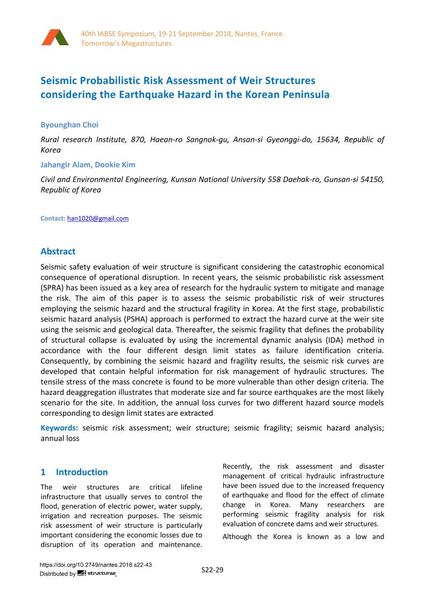Seismic Probabilistic Risk Assessment of Weir Structures considering the Earthquake Hazard in the Korean Peninsula

|
|
|||||||||||
Bibliografische Angaben
| Autor(en): |
Byounghan Choi
(Rural research Institute, 870, Haean-ro Sangnok-gu, Ansan-si Gyeonggi-do, 15634, Republic of Korea)
Jahangir Alam (Civil and Environmental Engineering, Kunsan National University 558 Daehak-ro, Gunsan-si 54150, Republic of Korea) Dookie Kim (Civil and Environmental Engineering, Kunsan National University 558 Daehak-ro, Gunsan-si 54150, Republic of Korea) |
||||
|---|---|---|---|---|---|
| Medium: | Tagungsbeitrag | ||||
| Sprache(n): | Englisch | ||||
| Tagung: | IABSE Symposium: Tomorrow’s Megastructures, Nantes, France, 19-21 September 2018 | ||||
| Veröffentlicht in: | IABSE Symposium Nantes 2018 | ||||
|
|||||
| Seite(n): | S22-29 | ||||
| Anzahl der Seiten (im PDF): | 8 | ||||
| DOI: | 10.2749/nantes.2018.s22-43 | ||||
| Abstrakt: |
Seismic safety evaluation of weir structure is significant considering the catastrophic economical consequence of operational disruption. In recent years, the seismic probabilistic risk assessment (SPRA) has been issued as a key area of research for the hydraulic system to mitigate and manage the risk. The aim of this paper is to assess the seismic probabilistic risk of weir structures employing the seismic hazard and the structural fragility in Korea. At the first stage, probabilistic seismic hazard analysis (PSHA) approach is performed to extract the hazard curve at the weir site using the seismic and geological data. Thereafter, the seismic fragility that defines the probability of structural collapse is evaluated by using the incremental dynamic analysis (IDA) method in accordance with the four different design limit states as failure identification criteria. Consequently, by combining the seismic hazard and fragility results, the seismic risk curves are developed that contain helpful information for risk management of hydraulic structures. The tensile stress of the mass concrete is found to be more vulnerable than other design criteria. The hazard deaggregation illustrates that moderate size and far source earthquakes are the most likely scenario for the site. In addition, the annual loss curves for two different hazard source models corresponding to design limit states are extracted |
||||
